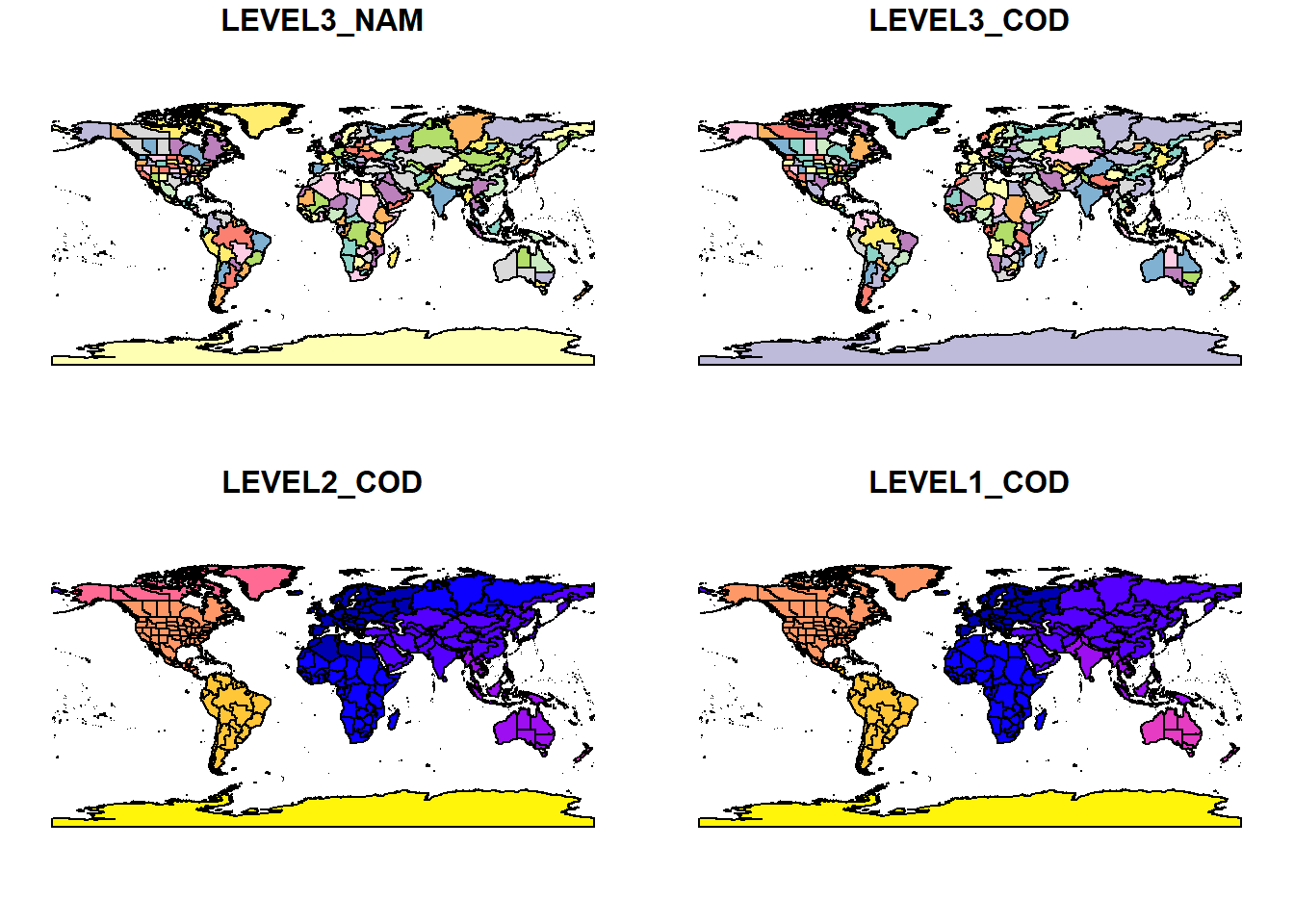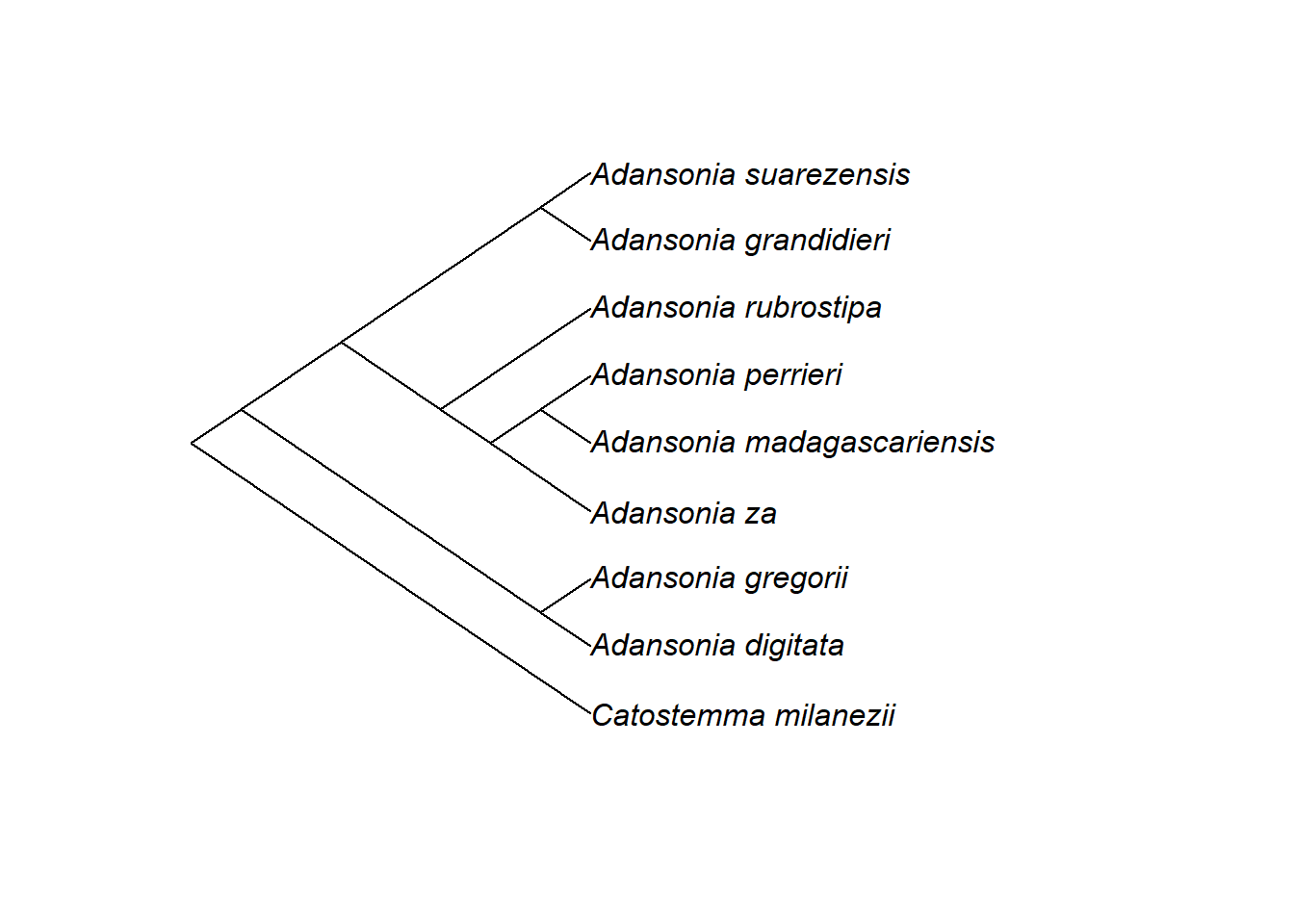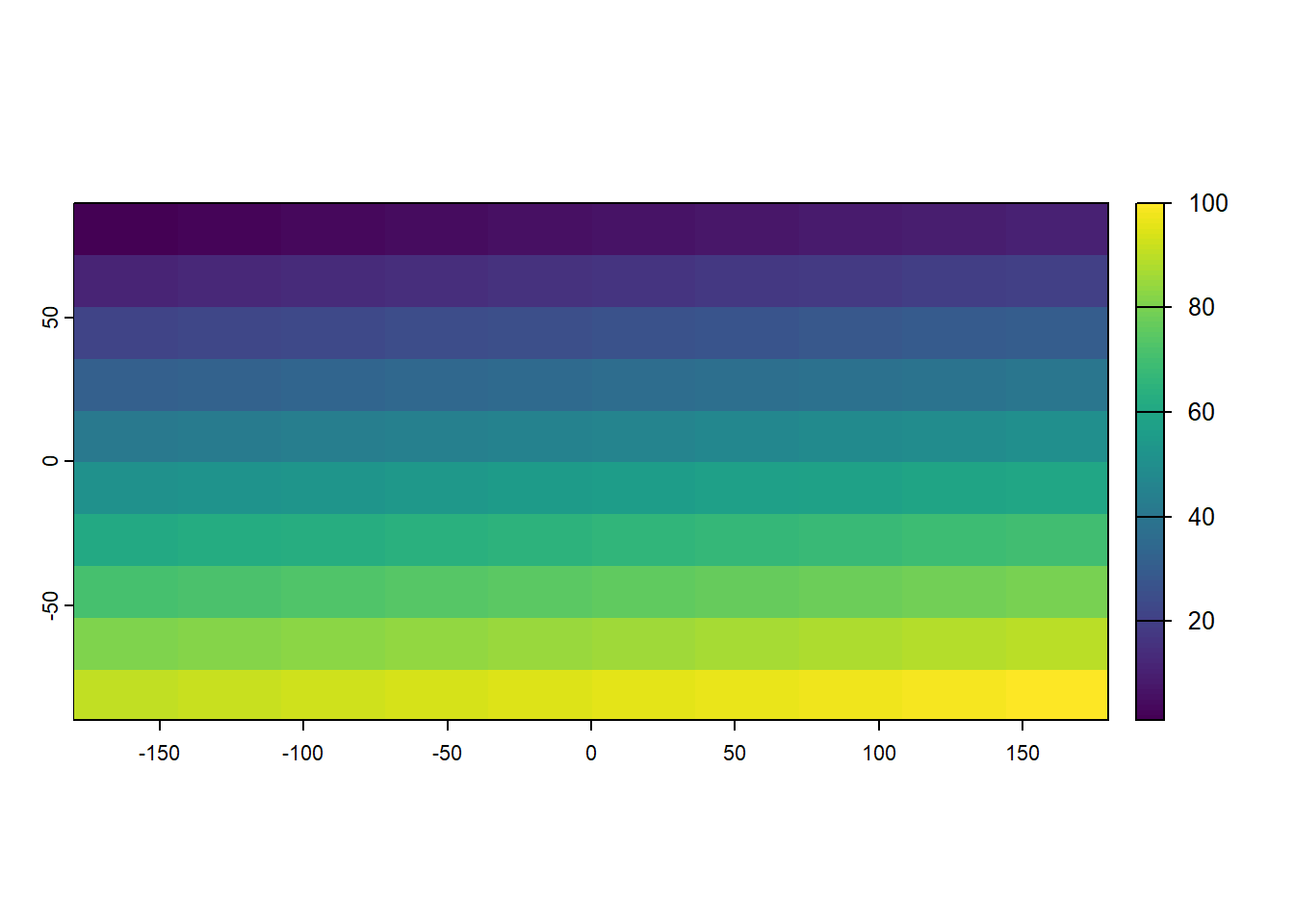1.11 Spatial Data in R
1.11.1 Background
In ecological and geographical research, it is common to work with data that has a spatial component—that is, data associated with a specific location on Earth. For example, we might study the elevation of a forest plot, the location of a species observation, or the climate of a region. These types of data are known as spatial data, and they allow us to connect real-world phenomena with their geographic position.
Spatial data is the foundation of Geographic Information Systems (GIS), which are tools used to store, analyze, and visualize geographical information. While many researchers use GIS software such as QGIS or ArcGIS, R also offers powerful tools for handling spatial data, especially for analysis and automation.
There are two main formats of spatial data:
- Vector data, which represents discrete objects like points (e.g., species occurrences), lines (e.g., roads), or polygons (e.g., country borders).
- Raster data, which represents continuous surfaces such as temperature, elevation, or land cover, typically stored in a regular grid of pixels.
In this lesson, we introduce two R packages widely used to work with spatial data:
sf(Simple Features): for vector dataterra: for raster data
The goal is to explore the basic structure of spatial objects and understand how to interact with them in R. This will prepare you for more advanced operations like mapping, which we will cover in the next lesson.
1.11.2 Learning objectives
By the end of this lesson, you will be able to:
- Recognize and describe vector and raster data structures in R.
- Use
sfandterrato load, explore, and filter spatial data. - Understand basic spatial metadata: CRS, resolution, and extent.
- Export spatial objects to common GIS file formats.
1.11.3 Contents
This session introduces the basic logic of working with spatial data in R. Important spatial concepts:
- Geometry: The shape or location (e.g., a point or polygon).
- Attributes: Descriptive data linked to each feature (e.g., country name, elevation).
- CRS (Coordinate Reference System): Tells R how to interpret the coordinates (e.g., in meters or degrees).
- Raster resolution: The size of each pixel in a raster layer.
This session focuses on exploring data, not creating maps. The next lesson will cover visualization.
1.11.4 Literature
- Geocomputation with R, Chapters 2, 4 & 6. https://r.geocompx.org/
1.11.6 Tutorial: Exploring spatial data with sf and terra
1.11.6.1 Loading libraries
Before you begin, make sure you have the sf package installed. You can install it with the following command:
## Warning: Paket 'sf' wurde unter R Version 4.4.3 erstellt## Linking to GEOS 3.13.0, GDAL 3.10.1, PROJ 9.5.1; sf_use_s2() is TRUE## Warning: Paket 'terra' wurde unter R Version 4.4.3 erstellt## terra 1.8.54##
## Attache Paket: 'terra'## Das folgende Objekt ist maskiert 'package:phytools':
##
## rescale## Die folgenden Objekte sind maskiert von 'package:ape':
##
## rotate, trans, zoom## ── Attaching core tidyverse packages ────────────────────────── tidyverse 2.0.0 ──
## ✔ dplyr 1.1.4 ✔ readr 2.1.5
## ✔ forcats 1.0.0 ✔ stringr 1.5.1
## ✔ ggplot2 3.5.1 ✔ tibble 3.2.1
## ✔ lubridate 1.9.3 ✔ tidyr 1.3.1
## ✔ purrr 1.0.2## ── Conflicts ──────────────────────────────────────────── tidyverse_conflicts() ──
## ✖ tidyr::extract() masks terra::extract()
## ✖ dplyr::filter() masks stats::filter()
## ✖ dplyr::lag() masks stats::lag()
## ✖ purrr::map() masks maps::map()
## ✖ dplyr::where() masks ape::where()
## ℹ Use the conflicted package (<http://conflicted.r-lib.org/>) to force all conflicts to become errors1.11.6.2 Vector Data using Simple Feature Classes sf
The sf package in R is a powerful tool for working with spatial data. It provides a wide range of functions and methods for reading, writing, manipulating, and visualizing spatial data. In this tutorial, we will cover several essential aspects of working with the sf package:
1.11.6.3 Creating Simple Feature Geometry (SFG) Objects
Create points
# Create a simple feature geometry with 3 points
points <- st_sfc(
st_point(c(0, 0)),
st_point(c(1, 1)),
st_point(c(2, 2))
)
# Display structure
points## Geometry set for 3 features
## Geometry type: POINT
## Dimension: XY
## Bounding box: xmin: 0 ymin: 0 xmax: 2 ymax: 2
## CRS: NA## POINT (0 0)## POINT (1 1)## POINT (2 2)Create polygons
# Create two polygons and store as an SFC object
polygons <- st_sfc(
st_polygon(list(rbind(c(0,0), c(0,1), c(1,1), c(1,0), c(0,0)))),
st_polygon(list(rbind(c(1,1), c(1,2), c(2,2), c(2,1), c(1,1))))
)
# Display
polygons## Geometry set for 2 features
## Geometry type: POLYGON
## Dimension: XY
## Bounding box: xmin: 0 ymin: 0 xmax: 2 ymax: 2
## CRS: NA## POLYGON ((0 0, 0 1, 1 1, 1 0, 0 0))## POLYGON ((1 1, 1 2, 2 2, 2 1, 1 1))To create a multipoint object from scratch, we use the st_multipoint function.
# Erstellen eines Mehrpunktobjekts von Grund auf
multipoints <- st_multipoint(x = matrix(c(0, 0), c(1, 1), c(2, 2)))
# Drucken des Mehrpunktobjekts
multipoints## MULTIPOINT ((0 0))1.11.6.4 Creating a Multi-Point Object from a .csv File
You can also create multipoint objects from CSV data. First, load a CSV file with spatial coordinates. You can find the sample data on ILIAS. Remember to specify your working directory and the correct path.
1.11.6.5 Creating multi-polygon objects from a shapefile
You can create a multi-polygon object from a shapefile using the st_read function; for example, use the Level 3 Botanical Lands, which you must first unpack.
# Read a shapefile (e.g., botanical boundaries)
polygons_from_shapefile <- st_read("data/bot_count.shp")## Reading layer `bot_count' from data source
## `C:\Users\zizka_lokal\Dropbox\01_projects\00_bsc_AM_biodiv_pflanzen_2025\Übung\bsc-biodiv-der-pflanzen\data\bot_count.shp'
## using driver `ESRI Shapefile'
## Simple feature collection with 369 features and 4 fields
## Geometry type: MULTIPOLYGON
## Dimension: XY
## Bounding box: xmin: -180 ymin: -90 xmax: 179.9999 ymax: 83.62361
## Geodetic CRS: WGS 84
1.11.6.6 Filtering and selecting attributes
You can filter and summarize data based on attributes by using the dplyr package in combination with the sf package.
# Filter polygons with LEVEL1_COD equal to 7
filtered_polygons <- polygons_from_shapefile %>%
filter(LEVEL1_COD == 7)
# Filter where LEVEL1_COD > 5
filtered_polygons <- polygons_from_shapefile %>%
filter(LEVEL1_COD > 5)
# Select specific attribute columns
selected_attributes <- polygons_from_shapefile %>%
select(LEVEL3_COD, LEVEL3_NAM)
# Display result
head(selected_attributes)## Simple feature collection with 6 features and 2 fields
## Geometry type: MULTIPOLYGON
## Dimension: XY
## Bounding box: xmin: -120.0014 ymin: -55.05169 xmax: 74.91577 ymax: 60
## Geodetic CRS: WGS 84
## LEVEL3_COD LEVEL3_NAM geometry
## 1 ABT Alberta MULTIPOLYGON (((-114.8308 5...
## 2 AFG Afghanistan MULTIPOLYGON (((71.24197 38...
## 3 AGE Argentina Northeast MULTIPOLYGON (((-61.86666 -...
## 4 AGS Argentina South MULTIPOLYGON (((-68.59916 -...
## 5 AGW Argentina Northwest MULTIPOLYGON (((-65.75386 -...
## 6 ALA Alabama MULTIPOLYGON (((-88.16472 3...1.11.6.7 Saving spatial data to disk
# Save spatial object to a new shapefile
st_write(polygons_from_shapefile, "data/test_shapefile.shp", delete_layer = TRUE)## Deleting layer `test_shapefile' using driver `ESRI Shapefile'
## Writing layer `test_shapefile' to data source
## `data/test_shapefile.shp' using driver `ESRI Shapefile'
## Writing 369 features with 4 fields and geometry type Multi Polygon.1.11.7 Optional: Spatial data tutorial
1.11.7.1 Exploring built-in sf data
We’ll use a built-in dataset that comes with the sf package:
# Example vector data: country polygons
world <- st_read(system.file("shape/nc.shp", package = "sf"))## Reading layer `nc' from data source
## `C:\Users\zizka_lokal\AppData\Local\Programs\R\R-4.4.2\library\sf\shape\nc.shp'
## using driver `ESRI Shapefile'
## Simple feature collection with 100 features and 14 fields
## Geometry type: MULTIPOLYGON
## Dimension: XY
## Bounding box: xmin: -84.32385 ymin: 33.88199 xmax: -75.45698 ymax: 36.58965
## Geodetic CRS: NAD27## [1] "sf" "data.frame"## Simple feature collection with 6 features and 14 fields
## Geometry type: MULTIPOLYGON
## Dimension: XY
## Bounding box: xmin: -81.74107 ymin: 36.07282 xmax: -75.77316 ymax: 36.58965
## Geodetic CRS: NAD27
## AREA PERIMETER CNTY_ CNTY_ID NAME FIPS FIPSNO CRESS_ID BIR74 SID74
## 1 0.114 1.442 1825 1825 Ashe 37009 37009 5 1091 1
## 2 0.061 1.231 1827 1827 Alleghany 37005 37005 3 487 0
## 3 0.143 1.630 1828 1828 Surry 37171 37171 86 3188 5
## 4 0.070 2.968 1831 1831 Currituck 37053 37053 27 508 1
## 5 0.153 2.206 1832 1832 Northampton 37131 37131 66 1421 9
## 6 0.097 1.670 1833 1833 Hertford 37091 37091 46 1452 7
## NWBIR74 BIR79 SID79 NWBIR79 geometry
## 1 10 1364 0 19 MULTIPOLYGON (((-81.47276 3...
## 2 10 542 3 12 MULTIPOLYGON (((-81.23989 3...
## 3 208 3616 6 260 MULTIPOLYGON (((-80.45634 3...
## 4 123 830 2 145 MULTIPOLYGON (((-76.00897 3...
## 5 1066 1606 3 1197 MULTIPOLYGON (((-77.21767 3...
## 6 954 1838 5 1237 MULTIPOLYGON (((-76.74506 3...## AREA PERIMETER CNTY_ CNTY_ID
## Min. :0.0420 Min. :0.999 Min. :1825 Min. :1825
## 1st Qu.:0.0910 1st Qu.:1.324 1st Qu.:1902 1st Qu.:1902
## Median :0.1205 Median :1.609 Median :1982 Median :1982
## Mean :0.1263 Mean :1.673 Mean :1986 Mean :1986
## 3rd Qu.:0.1542 3rd Qu.:1.859 3rd Qu.:2067 3rd Qu.:2067
## Max. :0.2410 Max. :3.640 Max. :2241 Max. :2241
## NAME FIPS FIPSNO CRESS_ID
## Length:100 Length:100 Min. :37001 Min. : 1.00
## Class :character Class :character 1st Qu.:37051 1st Qu.: 25.75
## Mode :character Mode :character Median :37100 Median : 50.50
## Mean :37100 Mean : 50.50
## 3rd Qu.:37150 3rd Qu.: 75.25
## Max. :37199 Max. :100.00
## BIR74 SID74 NWBIR74 BIR79
## Min. : 248 Min. : 0.00 Min. : 1.0 Min. : 319
## 1st Qu.: 1077 1st Qu.: 2.00 1st Qu.: 190.0 1st Qu.: 1336
## Median : 2180 Median : 4.00 Median : 697.5 Median : 2636
## Mean : 3300 Mean : 6.67 Mean :1050.8 Mean : 4224
## 3rd Qu.: 3936 3rd Qu.: 8.25 3rd Qu.:1168.5 3rd Qu.: 4889
## Max. :21588 Max. :44.00 Max. :8027.0 Max. :30757
## SID79 NWBIR79 geometry
## Min. : 0.00 Min. : 3.0 MULTIPOLYGON :100
## 1st Qu.: 2.00 1st Qu.: 250.5 epsg:4267 : 0
## Median : 5.00 Median : 874.5 +proj=long...: 0
## Mean : 8.36 Mean : 1352.8
## 3rd Qu.:10.25 3rd Qu.: 1406.8
## Max. :57.00 Max. :11631.0
1.11.7.2 Accessing spatial metadata
## Coordinate Reference System:
## User input: NAD27
## wkt:
## GEOGCRS["NAD27",
## DATUM["North American Datum 1927",
## ELLIPSOID["Clarke 1866",6378206.4,294.978698213898,
## LENGTHUNIT["metre",1]]],
## PRIMEM["Greenwich",0,
## ANGLEUNIT["degree",0.0174532925199433]],
## CS[ellipsoidal,2],
## AXIS["latitude",north,
## ORDER[1],
## ANGLEUNIT["degree",0.0174532925199433]],
## AXIS["longitude",east,
## ORDER[2],
## ANGLEUNIT["degree",0.0174532925199433]],
## ID["EPSG",4267]]## [1] "AREA" "PERIMETER" "CNTY_" "CNTY_ID" "NAME" "FIPS"
## [7] "FIPSNO" "CRESS_ID" "BIR74" "SID74" "NWBIR74" "BIR79"
## [13] "SID79" "NWBIR79" "geometry"# Subset example
subset_world <- world[1:5, c("NAME", "AREA")]
# Export (optional)
st_write(subset_world, "data/subset_world.shp", delete_layer = TRUE)## Deleting layer `subset_world' using driver `ESRI Shapefile'
## Writing layer `subset_world' to data source
## `data/subset_world.shp' using driver `ESRI Shapefile'
## Writing 5 features with 2 fields and geometry type Multi Polygon.1.11.7.3 Working with raster data using terra
Now let’s look at raster data:
# Load package
library(terra)
# Create dummy raster
r <- rast(nrows = 10, ncols = 10, vals = 1:100)
# Display raster
plot(r)
## class : SpatRaster
## size : 10, 10, 1 (nrow, ncol, nlyr)
## resolution : 36, 18 (x, y)
## extent : -180, 180, -90, 90 (xmin, xmax, ymin, ymax)
## coord. ref. : lon/lat WGS 84 (CRS84) (OGC:CRS84)
## source(s) : memory
## name : lyr.1
## min value : 1
## max value : 100## [1] 36 18## SpatExtent : -180, 180, -90, 90 (xmin, xmax, ymin, ymax)## [1] "GEOGCRS[\"WGS 84 (CRS84)\",\n DATUM[\"World Geodetic System 1984\",\n ELLIPSOID[\"WGS 84\",6378137,298.257223563,\n LENGTHUNIT[\"metre\",1]]],\n PRIMEM[\"Greenwich\",0,\n ANGLEUNIT[\"degree\",0.0174532925199433]],\n CS[ellipsoidal,2],\n AXIS[\"geodetic longitude (Lon)\",east,\n ORDER[1],\n ANGLEUNIT[\"degree\",0.0174532925199433]],\n AXIS[\"geodetic latitude (Lat)\",north,\n ORDER[2],\n ANGLEUNIT[\"degree\",0.0174532925199433]],\n USAGE[\n SCOPE[\"unknown\"],\n AREA[\"World\"],\n BBOX[-90,-180,90,180]],\n ID[\"OGC\",\"CRS84\"]]"1.11.7.4 Basic raster operations
## lyr.1
## [1,] 1
## [2,] 2
## [3,] 3
## [4,] 4
## [5,] 5
## [6,] 6
## [7,] 7
## [8,] 8
## [9,] 9
## [10,] 10
## [11,] 11
## [12,] 12
## [13,] 13
## [14,] 14
## [15,] 15
## [16,] 16
## [17,] 17
## [18,] 18
## [19,] 19
## [20,] 20
## [21,] 21
## [22,] 22
## [23,] 23
## [24,] 24
## [25,] 25
## [26,] 26
## [27,] 27
## [28,] 28
## [29,] 29
## [30,] 30
## [31,] 31
## [32,] 32
## [33,] 33
## [34,] 34
## [35,] 35
## [36,] 36
## [37,] 37
## [38,] 38
## [39,] 39
## [40,] 40
## [41,] 41
## [42,] 42
## [43,] 43
## [44,] 44
## [45,] 45
## [46,] 46
## [47,] 47
## [48,] 48
## [49,] 49
## [50,] 50
## [51,] 51
## [52,] 52
## [53,] 53
## [54,] 54
## [55,] 55
## [56,] 56
## [57,] 57
## [58,] 58
## [59,] 59
## [60,] 60
## [61,] 61
## [62,] 62
## [63,] 63
## [64,] 64
## [65,] 65
## [66,] 66
## [67,] 67
## [68,] 68
## [69,] 69
## [70,] 70
## [71,] 71
## [72,] 72
## [73,] 73
## [74,] 74
## [75,] 75
## [76,] 76
## [77,] 77
## [78,] 78
## [79,] 79
## [80,] 80
## [81,] 81
## [82,] 82
## [83,] 83
## [84,] 84
## [85,] 85
## [86,] 86
## [87,] 87
## [88,] 88
## [89,] 89
## [90,] 90
## [91,] 91
## [92,] 92
## [93,] 93
## [94,] 94
## [95,] 95
## [96,] 96
## [97,] 97
## [98,] 98
## [99,] 99
## [100,] 1001.11.8 Tasks
Write an introductory paragraph explaining the difference between vector and raster data. Mention at least two examples of each in ecological research.
Use the st_read() function to load a shapefile of your choice (you can use bot_count.shp from class or one from a public source). Filter the dataset to show only a specific region, and save the filtered object as a new shapefile.
Create a raster object using the rast() function and populate it with random values. Crop the raster using a spatial extent and plot the result. What happens when you change the resolution?
Extract the CRS, extent, and resolution of both a vector and raster object. Compare them. What does this information tell you, and why is it important?